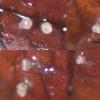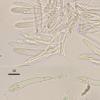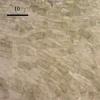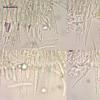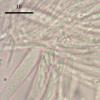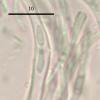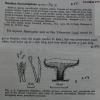
08-11-2025 00:29
 Francois Guay
Francois Guay
I found this species in Quebec, Canada, on herbace

04-11-2025 09:07
Hello.A suspected Hymenoscyphus sprouting on a thi

04-11-2025 12:43
 Edvin Johannesen
Edvin Johannesen
Hi! One more found on old Populus tremula log in O

03-11-2025 21:34
 Edvin Johannesen
Edvin Johannesen
These tiny (0.4-0.5 mm diam.), whitish, short-stip

28-10-2025 15:37
Carl FarmerI'd be grateful for any suggestions for this strik

03-11-2025 16:30
 Hans-Otto Baral
Hans-Otto Baral
Hello I want to ask you if you have found this ye
Hyaloscyphaceae gen. sp.
Nina Filippova,
17-07-2013 17:03
Apothecia cupulate, stipitate, tiny, 110–180 mkin diameter, 150–210 high; outer surface hairy and slightly powdery, receptacle white, stem brownish.
Excipulum in stem from brown segmented hyphae, at flanks from enlarged ellipsoid cells about 7 in diameter, with thickened walls; hairs arise from stem, outer surface and edge, conical (gradually narrowing to tip), hyaline (brown in stem), not strongly incrusted, 21–32 x 2.6–3.5; asci clavate, with crozier, with euamyloid small ring, 35.7–42 x 4.9–6.2; paraphyses cylindrical, slightly enlarged at tips, with pale elongated vacuoles, medium size 31 x 1.6; spores pip-shaped, hyaline, without oils, 5.2 x 1.5 (n=2).?
Hans-Otto Baral,
17-07-2013 17:19

Re : Hyaloscyphaceae gen. sp.
I think it is Betulina fuscostipitata, now placed in Hyaloscypha. The genus Fuscoscypha was an option to transfer the species, but molecular results indicated that this genus should be merged with Hyaloscypha.
Hyaloscypha fuscostipitata (Graddon) Baral & Huhtinen, Karstenia 49(1): 15 (2009)
I know it from Castanea and Carpinus leaves, but he type was on Betula.
Zotto
Hyaloscypha fuscostipitata (Graddon) Baral & Huhtinen, Karstenia 49(1): 15 (2009)
I know it from Castanea and Carpinus leaves, but he type was on Betula.
Zotto
Nina Filippova,
17-07-2013 17:41
Re : Hyaloscyphaceae gen. sp.
Very interesting, and thank you, i will do final comparisons some later as well.

